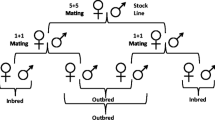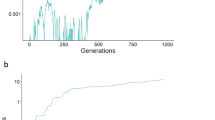Abstract
Matings betweenDrosophila pseudoobscura strains differeing at the amylase (Amy) locus were observed in Elens-Wattiaux chambers. Males homozygous for eitherAmy 1.00 orAmy 0.84 alleles in the CH gene arrangement enjoyed a mating advantage when moderately rare, but none when quite rare. The minority male advantage for strains differing at theAmy locus, and other loci linked to it, was comparable in size to that observed between strains carrying the ST or CH gene arrangements, and either alike or different at theAmy locus. Although some features of our results are puzzling, there is evidence that theAmy locus and others for which it serves as a marker have effects on mating behavior which include some degree of rare male mating advantage.
Similar content being viewed by others
References
Ayala, F. J., and Campbell, C. A. (1974). Frequency-dependent selection.Ann. Rev. Ecol. Syst. 5:115–138.
Chetverikov, S. S. (1926). On certain features of the evolutionary process from the viewpoint of modern genetics.J. Exp. Biol. (Russian),2:3–54 (English translation, 1961, inProc. Am. Phil. Soc. 105:167–195).
Ehrman, L., and Parsons, P. A. (1976).The Genetics of Behavior, Sinauer, Sunderland, Mass.
Elens, A. A., and Wattiaux, J. M. (1964). Direct observation of sexual isolation.Drosophila Inform. Serv. 39:118–119.
Lewontin, R. C. (1974).The Genetic Basis of Evolutionary Change, Columbia University Press, New York.
Lewontin, R. C., and Hubby, J. L. (1966). A molecular approach to the study of genic heterozygosity in natural populations. II. Amount of variation and degree of heterozygosity in natural populations ofD. pseudoobscura.Genetics 54:549–609.
Powell, J. R. (1975). Protein variation in natural populations of animals. In Dobzhansky, T., Hecht, M. K., and Steere, W. C. (eds.),Evolutionary Biology, Vol. 8, Plenum, New York, pp. 79–120.
Spiess, E. B. (1970). Mating propensity and its genetic basis inDrosophila. In Hecht, M. K., and Steere, W. C. (eds.),Essays in Evolution and Genetics, Appleton-Century-Crofts, New York, pp. 315–379.
Author information
Authors and Affiliations
Rights and permissions
About this article
Cite this article
Ehrman, L., Anderson, W. & Blatte, L. A test for rare male mating advantage at an “enzyme locus” inDrosophila . Behav Genet 7, 427–432 (1977). https://doi.org/10.1007/BF01066777
Received:
Issue Date:
DOI: https://doi.org/10.1007/BF01066777




